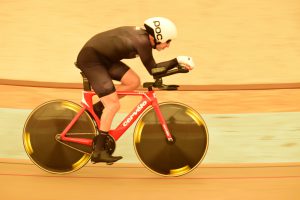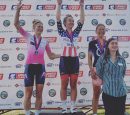
October 17, 2022
Everyone has goals; for some, it's just to get out of bed in the morning, and others may want to become astronauts and rocket to the moon or Mars. I have spent years trying to break a world record in cycling. Unfortunately, the last four years have thrown curveballs at me- such as recovering from heart disease, a broken hip last year, and COVID this year!
Everyone has goals; for some, it's just to get out of bed in the morning, and others may want to become astronauts and rocket to the moon or Mars. I have spent years trying to break a world record in cycling. Unfortunately, the last four years have thrown curveballs at me- such as recovering from heart disease, a broken hip last year, and COVID this year!
On September 27, 2022, I competed at the world cycling track championships in Carson, CA, to attempt a 2-kilometer world championship race. Unfortunately, I had a terrible race and, in the process, contracted COVID. I was probably infected when racing, which could account for my poor performance. To make matters worse, I was also planning to attempt a world record in the hour time trial in Aguascalientes, Mexico on October 17th, just three weeks away. How could I do this after such a poor performance only three weeks earlier?!
My wife and I were organizing the event in Mexico so we felt obligated to go even though I was very ill with Covid. I was able to start on Paxlovid, the antiviral medication that works against the virus. Unfortunately, I had a high fever and could not ride my bike when I would have been tapering to peak for my world record attempt. This year was a little deja vu as when last year, in 2021, I broke my hip three months before my world record attempt and still managed to break the national record. I didn't want to go through that again, so I decided not to go… however, my wife had other ideas and encouraged me to go, so we did.
The" hour" time trial record is considered the most prestigious time trial in cycling, and for good reason. It is challenging since one must go as hard as possible for one hour. No matter how fast or hard you go, the event still lasts one hour. No matter if you go faster, the event doesn't end quicker. It s the distance that matters! This is unlike any other race.
Pacing is crucial since there isn't a reward for crossing the finish line sooner than an hour; you just have to keep going, which takes a lot of practice. The first half always seems like you are not going fast enough, but that soon fades, and by the last 10 minutes, you feel like you won't make it; that is, if you paced yourself correctly. IT'S ALWAYS VERY HARD….and you're not allowed to eat or drink during the ride. Additionally, you can't look at your heart rate, power output, or any of that- all you can rely on for information is for someone to yell your lap times to you.
The Hour event is always held on a banked wooden track called a velodrome.The fastest track is considered to be in Aguascalientes, Mexico, at 6,000 feet altitude. The banking on this indoor 250-meter track is close to 40%, so about half the time you're riding on the track, you're experiencing almost double your body weight in the turns as centrifugal force pushes down. This force makes you weigh more and stresses your whole body, particularly on the saddle in your sit-bones area. This ist extremely uncomfortable, no matter how much conditioning your backside might have. Honestly, my biggest fear was that I couldn't handle the pain of riding in that same position for the entire hour at full power.
Upon arriving in Mexico, I had only one day to prepare for the event. On Sunday, I went to the track and tested to figure out what kind of fitness I had left after covid and what pacing I could do in terms of lap times. I decided at that point that I would not be able to go after the world record but maybe could go after one of my two national records. I currently hold the Paracycling national record for the hour at 46.250 kilometers/ 28.9 miles and had the Masters 60+ record at 44.935 kilometers/ 27.8 miles in an hour.
Day of race: After settling in and understanding what the track's temperature was going to be (warmer temperatures are faster but also put more physiological stresses on the body so this is a balancing act to get the temperature right) and what my pace was going to be, it was time to get suited up and get to the start line.
At the start of timed races, you are locked into a holding device that grabs the bike and will not release until the timer counts down to zero. So as the bell went off, I had no doubts that I had to stay at a steady pace and go as hard as possible within reason and pace slightly below what was predicted to break the National record – this was around 19.8 seconds each lap. Also, I had to manage my pain when I sat on the saddle by gently lifting off to unweight myself once or twice every lap to ensure I had the endurance to last. I've done this attempt the past four times, and the pain was so excruciating as I was pushed into the bike saddle. Every time I went for a record, I had to let up at the end because I couldn't handle the pain of sitting. I didn't want that to happen again.
Nutritionally, I also did things differently: this time, I took in three grams of sodium and several 100-calorie gel packs full of carbohydrates right before the start to ensure I had enough fuel on board. After the start, no food or drink is allowed! The salt helped me hang on to the water that I drank as long as I could and gave me enough sodium that my muscles could work well…as it turns out that I'm a heavy sweater and also have a high sodium content in my sweat and can sweat out as much as 2 grams of salt an hour, so I had to be careful to make sure I maintained my salt and fluid levels before I started the event. My wife was my lap counter, and my coach, Todd Scheske, gave me lap times.
The first 10 minutes or so were great. I kept within the range I wanted, and everything looked good and felt good. But as I progressed, fatigue began to settle in. At 30 minutes, I noticed that I was starting to have some pain sitting down, breathing harder, and getting more exhausted. So now the questions began: did I have enough fitness after three weeks off from a bad case of covid; did I recover enough; could I stand the g forces in the turns?... I didn't know, so I slowed down a little. I wanted to catch my breath because I wasn't sure I could complete the race, and at this point, I was slightly ahead of the National record I set last year and knew I could afford some rest.
I wondered if I could hold this pace as time passed, so I backed off a little more. My lap times went from 19.5 seconds per lab to around 20 seconds per lap. Now my speed was over 28 miles an hour. My overall average pace was close to 28.3 miles an hour. My speed was still pretty tight, and I became more confident as time passed. My wife was calling out that I was very close to my para-cycling record, so I pushed it hard with about 15 minutes to go but paid the price of going into oxygen debt (not a good thing in an event that is 100% aerobic) before the hour was over.
Then came the last five minutes, and they were excruciating!! I wasn't sure I could make it and wanted to quit- the mind plays crazy games in these types of efforts. Filippo Gana, who just broke the professional hour record, said he wanted to crash or get a flat tire so he could stop, and he's the best in the world!!
As time ticked down, and so did my laps, I could not believe the joy I felt when I could stop peddling. It was more relief than happiness. Soon after, I got official confirmation that I had broken my national record by over two laps, over half a kilometer, putting me in the record books for my third national record. The previous record stood as the world record for eight years until a New Zealander set a new world record.
I couldn't hide my disappointment because I was going for the world record and had this extraordinary issue with being ill with COVID right before my event. But, still, I couldn't deny that I had broken a record that I thought was unattainable, given that I had been so sick just two weeks before.
On September 27, 2022, I competed at the world cycling track championships in Carson, CA, to attempt a 2-kilometer world championship race. Unfortunately, I had a terrible race and, in the process, contracted COVID. I was probably infected when racing, which could account for my poor performance. To make matters worse, I was also planning to attempt a world record in the hour time trial in Aguascalientes, Mexico on October 17th, just three weeks away. How could I do this after such a poor performance only three weeks earlier?!
My wife and I were organizing the event in Mexico so we felt obligated to go even though I was very ill with Covid. I was able to start on Paxlovid, the antiviral medication that works against the virus. Unfortunately, I had a high fever and could not ride my bike when I would have been tapering to peak for my world record attempt. This year was a little deja vu as when last year, in 2021, I broke my hip three months before my world record attempt and still managed to break the national record. I didn't want to go through that again, so I decided not to go… however, my wife had other ideas and encouraged me to go, so we did.
The" hour" time trial record is considered the most prestigious time trial in cycling, and for good reason. It is challenging since one must go as hard as possible for one hour. No matter how fast or hard you go, the event still lasts one hour. No matter if you go faster, the event doesn't end quicker. It s the distance that matters! This is unlike any other race.
Pacing is crucial since there isn't a reward for crossing the finish line sooner than an hour; you just have to keep going, which takes a lot of practice. The first half always seems like you are not going fast enough, but that soon fades, and by the last 10 minutes, you feel like you won't make it; that is, if you paced yourself correctly. IT'S ALWAYS VERY HARD….and you're not allowed to eat or drink during the ride. Additionally, you can't look at your heart rate, power output, or any of that- all you can rely on for information is for someone to yell your lap times to you.
The Hour event is always held on a banked wooden track called a velodrome.The fastest track is considered to be in Aguascalientes, Mexico, at 6,000 feet altitude. The banking on this indoor 250-meter track is close to 40%, so about half the time you're riding on the track, you're experiencing almost double your body weight in the turns as centrifugal force pushes down. This force makes you weigh more and stresses your whole body, particularly on the saddle in your sit-bones area. This ist extremely uncomfortable, no matter how much conditioning your backside might have. Honestly, my biggest fear was that I couldn't handle the pain of riding in that same position for the entire hour at full power.
Upon arriving in Mexico, I had only one day to prepare for the event. On Sunday, I went to the track and tested to figure out what kind of fitness I had left after covid and what pacing I could do in terms of lap times. I decided at that point that I would not be able to go after the world record but maybe could go after one of my two national records. I currently hold the Paracycling national record for the hour at 46.250 kilometers/ 28.9 miles and had the Masters 60+ record at 44.935 kilometers/ 27.8 miles in an hour.
Day of race: After settling in and understanding what the track's temperature was going to be (warmer temperatures are faster but also put more physiological stresses on the body so this is a balancing act to get the temperature right) and what my pace was going to be, it was time to get suited up and get to the start line.
At the start of timed races, you are locked into a holding device that grabs the bike and will not release until the timer counts down to zero. So as the bell went off, I had no doubts that I had to stay at a steady pace and go as hard as possible within reason and pace slightly below what was predicted to break the National record – this was around 19.8 seconds each lap. Also, I had to manage my pain when I sat on the saddle by gently lifting off to unweight myself once or twice every lap to ensure I had the endurance to last. I've done this attempt the past four times, and the pain was so excruciating as I was pushed into the bike saddle. Every time I went for a record, I had to let up at the end because I couldn't handle the pain of sitting. I didn't want that to happen again.
Nutritionally, I also did things differently: this time, I took in three grams of sodium and several 100-calorie gel packs full of carbohydrates right before the start to ensure I had enough fuel on board. After the start, no food or drink is allowed! The salt helped me hang on to the water that I drank as long as I could and gave me enough sodium that my muscles could work well…as it turns out that I'm a heavy sweater and also have a high sodium content in my sweat and can sweat out as much as 2 grams of salt an hour, so I had to be careful to make sure I maintained my salt and fluid levels before I started the event. My wife was my lap counter, and my coach, Todd Scheske, gave me lap times.
The first 10 minutes or so were great. I kept within the range I wanted, and everything looked good and felt good. But as I progressed, fatigue began to settle in. At 30 minutes, I noticed that I was starting to have some pain sitting down, breathing harder, and getting more exhausted. So now the questions began: did I have enough fitness after three weeks off from a bad case of covid; did I recover enough; could I stand the g forces in the turns?... I didn't know, so I slowed down a little. I wanted to catch my breath because I wasn't sure I could complete the race, and at this point, I was slightly ahead of the National record I set last year and knew I could afford some rest.
I wondered if I could hold this pace as time passed, so I backed off a little more. My lap times went from 19.5 seconds per lab to around 20 seconds per lap. Now my speed was over 28 miles an hour. My overall average pace was close to 28.3 miles an hour. My speed was still pretty tight, and I became more confident as time passed. My wife was calling out that I was very close to my para-cycling record, so I pushed it hard with about 15 minutes to go but paid the price of going into oxygen debt (not a good thing in an event that is 100% aerobic) before the hour was over.
Then came the last five minutes, and they were excruciating!! I wasn't sure I could make it and wanted to quit- the mind plays crazy games in these types of efforts. Filippo Gana, who just broke the professional hour record, said he wanted to crash or get a flat tire so he could stop, and he's the best in the world!!
As time ticked down, and so did my laps, I could not believe the joy I felt when I could stop peddling. It was more relief than happiness. Soon after, I got official confirmation that I had broken my national record by over two laps, over half a kilometer, putting me in the record books for my third national record. The previous record stood as the world record for eight years until a New Zealander set a new world record.
I couldn't hide my disappointment because I was going for the world record and had this extraordinary issue with being ill with COVID right before my event. But, still, I couldn't deny that I had broken a record that I thought was unattainable, given that I had been so sick just two weeks before.


